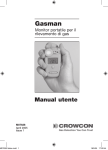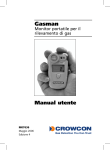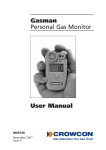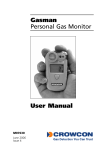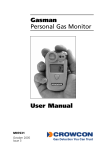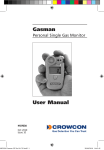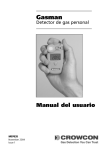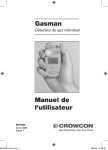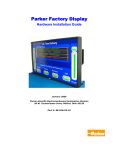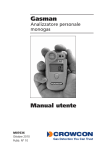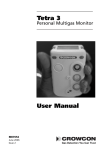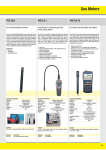Download Gasman User Manual
Transcript
Gasman Personal Gas Monitor User Manual M07630 November 2004 Issue 1 Safety information: • Read and understand all instructions in the operation section of this manual before use. • Do not substitute components as this may impair intrinsic safety and invalidate warranty. • Observe all warnings and instructions marked on the unit and within this manual. • Observe site health and safety procedures for gases being monitored and evacuation procedures. • Make sure you understand the screen display and alarm warnings. • If this product is not working properly, read the troubleshooting guide or call Crowcon. • Ensure qualified service personnel change sensors and operating system. • Ensure maintenance and calibration are carried out in accordance with the procedures in the manual. Instructions specific for use in hazardous areas The following instructions apply to equipment covered by certificate number: Baseefa04ATEX0383 Flammable Gas Baseefa04ATEX0384 Oxygen or Toxic Gas The following information covers all relevant points listed in clause 1.0.6 of the EHSR’s of the ATEX directive. 1. The certification marking is as follows: 3. The equipment is certified for use in ambient temperatures in the range –20°C to +65°C (-4 to +149 F). The equipment should not be used outside these ranges. 4. The equipment has not been assessed as a safety-related device (as referred to by the Directive 94/9/EC Annex II, clause 1.5) 5. Repair of this equipment and gas sensor replacement shall be carried out by the manufacturer or in accordance with the applicable code of practice. 6. If the equipment is likely to come into contact with aggressive substances, then it is the responsibility of the user to take suitable precautions that prevent it from being adversely affected, thus ensuring that the type of protection is not compromised. 7. The rechargeable battery must only be charged in non-hazardous (safe) areas by connection to the specified Crowcon charger. 8. Only the following cell types may be fitted in the battery compartment of the non-rechargeable battery pack: CR 2477 The cells must only be changed in a nonhazardous (safe) area. 9. The equipment is not certified for use in atmospheres containing more than 21% oxygen. Area Classifications: Zone 1: An area classified as Zone 1 is likely to have ignitable concentrations of flammable gases, vapours or liquids present under normal operating conditions. Zone 2: An area classified as Zone 2 is not likely to have ignitable concentrations of flammable gases, vapours or liquids present under normal operating conditions. Crowcon Detection Instruments Ltd 2 Blacklands Way, Abingdon OX14 1DY UK Tel. +44 (0)1235 557700 Fax. +44 (0)1235 557749 www.crowcon.com Email: [email protected] 2. The equipment may be used in Zones 1 and 2 for flammable versions and Zones 0, 1, and 2 for toxic and oxygen versions, for Group IIA, IIB, and IIC gases and vapours for Temperature Classes T1, T2, T3 and T4 © Copyright Crowcon Detection Instruments Ltd 2004. All rights are reserved. No part of the document may be photocopied, reproduced, or translated to another language without the prior written consent of Crowcon Detection Instruments Ltd. Publication number: M07630 First edition: November 2004 Gasman Personal Gas Monitor Contents Unpacking ................................................1 Quickstart guide ........................................3 Introduction ..............................................7 Operation..................................................9 Batteries ..................................................13 Alarm indications ....................................13 Fixing accessories ....................................16 Flow sampling ........................................17 Maintenance and calibration....................21 PC interface and software........................22 i-module replacement..............................23 Specification............................................25 Accessories and spare parts ....................26 Troubleshooting guide ............................28 Appendix: Limitations of sensors..............29 Gasman Unpacking Gasman Personal Gas Monitor Thank you for purchasing the new Gasman Personal Gas Monitor. Gasman has redefined portable gas monitoring and will give you years of unparalleled service and reliability. Please read the instructions carefully before use. Keep the manual for future reference. Unpacking Remove the Gasman Personal Gas Monitor from the packaging. The Gasman accessories will be located in the bottom of the box. Check the contents are complete, you should have: • Gasman unit with standard pocket clip; • A configuration report detailing the sensor installed, alarm settings and a calibration certificate; • Calibration flow cap and tubing; • User manual. Optional battery chargers and other accessories will be packed in a separate box. Gasman units ordered with an Alligator clip will receive this clip in place of the standard pocket clip. Battery check The Gasman Personal Gas Monitor has two battery options: Li-ion rechargeable or non-rechargeable batteries. Rechargeable units Gasman uses a Li-ion battery pack and should arrive with sufficient charge so that the unit can be used straight out the box. However, if this is the first time you have used the Gasman unit, you may need to charge the battery to attain the full operating time. (The actual operating time will depend on the types of sensor installed.) The flammable Gasman will operate for at least 12 hours on a fully charged battery. 1 Battery check Gasman Warning: rechargeable units Do not attempt to recharge the rechargeable battery with any other charger other than the Crowcon charger supplied with this unit. Failure to comply could invalidate safety certification and may result in permanent damage to the unit. 2 Gasman Quickstart guide Quickstart guide 1. Getting started Review your Gasman unit Switching on your unit Gasman requires little setting up, follow these simple steps to get your unit ready for use. 1. Ensure the unit is in clean air . 2. Switch on Press and hold the operator button for approximately 3 seconds until the red LEDs flash. The operator display screen will light up and the unit will begin a warm up sequence. 3 Quickstart guide Gasman Gasman warm up sequence a) The unit will test the alarm LEDs, sounder, vibration alerts, and the operator display screen. The sounder may be silenced by pressing the button. b) The unit will continue through a warm up sequence as shown below, this will take approximately 20 seconds. 10 second time out. c) Autozer o If Autozero is enabled (default), the unit will display the Autozero confirm screen: the display will alternate between ‘ZERO’ and ‘????’. Press the operator button with a single click to confirm Zero. If the operator button is not pressed within the 10 second time out, Gasman will proceed directly to Run mode without performing Zero. Run mode Your unit is now ready to use. Familiarise yourself with the gas being monitored in your unit and make sure you understand site health and safety procedures in the event of alarm conditions. 4 Gasman In the event of an alarm Confidence signals In normal Run mode, Gasman will emit a short beep accompanied by a blue LED flash every 10 seconds and the OK icon flashes to show operational health. These confidence signals can be disabled using the PC software. 2. In the event of an alar m Alarm signals In the event of gas concentrations exceeding the alarm thresholds for the gas being monitored, Gasman will activate the alarm signals. Alarm signals The red and blue alarm LEDs will flash, the sounder will emit a loud, fast series of beeps, the internal vibrator alarm will activate. The operator screen will display the alarm level and gas reading alternately. See the figure to the left. AL - 1 — Alarm level one AL - 2 — Alarm level two 1. When the gas level returns to normal, press the operator button. This will reset your Gasman unit to normal Run mode. If the gas level is still in alarm, the button will have no effect. The Gasman alarm is set to latch by default. The unit will still continue in alarm mode even when the gas level returns to normal, pressing the operator button will clear the alarm. 3. Switch off unit and storage Switching off unit 1. Press and hold the button for 5 seconds until the display shows OFF. The display will count down to switch off. 5 Additional information Gasman Storing conditions In order to optimise sensor performance and lifetime, your Gasman unit should be stored in a safe, non-hazardous area, 0-30°C, 10-90%RH. 4. Additional information For battery recharging information go to section III. For fixing accessories go to section V. For sampling section go to section VI. For calibration information go to section VII. For troubleshooting guide go to section XII. 6 Gasman Introduction I. Introduction Thank you for purchasing the new Gasman Personal Monitor. Gasman is a portable single gas detector, designed to be carried or worn by individuals working in hazardous environments such as confined spaces. It is suitable for use in classified hazardous areas. Gasman monitors a single gas and displays the reading on a display screen. Alarm warnings are given through a combination of a loud audible alarm, a bright visual alarm of blue/red flashing LEDs and an internal vibrator. Gasman can be fitted with a wide range of modular, plug and play gas sensors. The sensor carries an intelligent processor which contains calibration and sensor information. Gasman is battery operated and is available with rechargeable batteries or dry cell battery options. The dry cell battery option is only available for toxics and oxygen Gasman units. A battery charger for single and multiple Gasman units is available for rechargeable units, see section XI for more information. At Crowcon we recognised the need for a reliable and robust personal monitoring system, which is both small, light and easy to use. Gasman has a single operator button, and an intelligent user-friendly display with automatic backlight. The gas level is continuously monitored providing normal gas readings, peak readings and time weighted averages (TWA). Gasman is available as a diffusion sampling instrument, see section XI for sampling accessories. Configuration and data/event logging is handled by Crowcon Portables PC software, the PC communication link is provided as a link on the charger unit. Gasman’s compact shape and design makes it comfortable to wear and as nonintrusive as possible, with a non-slip grip for better handling. Extra accessories, such as pocket clip, hard hat clip, alligator clip, shoulder strap and chest harness, can be purchased. Gasman has been designed from top to bottom to bring you a lighter, compact design with single button operation for ease of use, maintenance and extreme reliability. Through innovative and rigorous design technology, we have introduced several new features. i-module gas sensor Gasman uses unique plug and play i-module sensor technology. Each sensor unit incorporates its own intelligent processor holding sensor configuration and calibration data. Different sensors can be purchased, and once inserted, are immediately ready to run. Flammable units are only available with rechargeable batteries. Plug and play will ease maintenance time and cost, and the intelligent 7 Introduction Gasman modular system will remove the need to calibrate the sensor. Gasman can be reconfigured by purchasing an additional pre-calibrated i-modules from your local supplier. Reliable, anti-shock mechanics and robust housing The Gasman housing is built from resilient material, giving it strength and flexibility to withstand the hardest of working conditions, water and dust tight to IP65 and IP67, with a non-slip grip. If the unit is dropped, there will be no disruption of power or function, ensuring reliability and service for years to come. Software The internal software in Gasman has been designed and written in accordance with the requirement of IEC 61508 to ensure quality and integrity of operation. Gasman has been designed to give a truly reliable personal gas monitoring system. The internal circuitry includes an independant watchdog, the software monitors for any malfunction within the unit and will display an error warning to the user should they occur. 8 Gasman Operation II. Operation 2.1 Switch-on sequence 1. Ensure the unit is in clean air . 2. Switch on Press and hold the operator button for approximately 3 seconds until the red LEDs flash. The instrument begins with testing all the LCD segments on the operator display screen, the red and blue alarm LEDs, sounder and internal vibrator alert. The sounder may be silenced by pressing the button. The unit enters a warm up mode and displays a sequence of screens, see page 3 for more details. At the end of warm up, the Autozero menu will be displayed. The Autozero function can be disabled or set to run automatically, without user confirmation: Autozero will not appear. See section VIII PC Interface and software. Battery check Use this time to check there is sufficient charge in the battery pack Calibration check During the warm up sequence, if the next calibration date is due in less than 31 days, ‘CAL - nn’ will be displayed, where nn is the number of days to the next calibration. If the date has expired, the Gasman unit will display a warning message ‘CAL’. The instrument can still function, but it is strongly recommended the unit is sent for calibration as soon as possible. Press the button to continue to Run mode. Gasman can be set, using the Portables PC software, for the instrument to lock in the event of the calibration date expiring, to prevent further operation of the instrument. 3. Autozer o Press the operator button with a single click to confirm NB. If Autozero Autozero. Flammable and toxic units will be set to read fails, a warning zero, and oxygen units set to read 20.9%. If the message will be operator button is not pressed within 10 seconds displayed. Gasman will proceed directly to normal operation without performing a zero. Switch of f To switch off the unit, press and hold the operator button for 5 9 Run mode Gasman seconds. The display will count down from 5, continue to hold the button until the unit counts down to shut off. 2.2 Run mode The Gasman unit displays the gas reading on the operator display screen. A typical display is shown below: The sensor channel will display the current value of the gas being monitored and units of measurement, the ‘OK’ symbol will flash indicating unit is working correctly. Familiarise yourself with the gas currently being monitored in your unit. Ensure you understand site health and safety procedures. For information on Peak and TWA readings, go to section 2.4. Confidence signals To reassure users the unit is working correctly, the Gasman unit will emit a short beep accompanied by a blue LED flash every 10 seconds and the OK icon will flash. 2.3 Display symbol guide Battery A full battery is represented by a battery icon showing a full three bars. A low battery charge will show 1 bar. When zero bars are shown the battery icon flashes and the sounder will emit warning bleeps. If the battery becomes too low, Gasman will switch off. TWA alarm Gasman will display the TWA alarm when the 15 minute or 8 hour time weighted average alarm threshold is passed for toxic gases. Gasman will display ‘LTWA’ and ‘STWA’, TWA alarms cannot be cleared. 10 Gasman Display options 2.4 Display options Gasman provides four additional selectable displays: Peak display When Peak mode is selected the instrument shows the highest value for flammable and toxic gases, or the lowest value for oxygen since switch on or last Peak Reset. This is useful for vertical entry checks where the whole instrument can be lowered down the shaft rather than using a sampling tube and for viewing peak exposure at the end of a shift. TWA display Shows the 15 minute or 8 hour time weighted average (TWA), for toxic gases, monitored since last turn on. Peak Reset Before a Peak entry test is performed select this menu option to clear any previously stored Peak value. Zero Performs Zero on your Gasman unit. How to display the menu 1. To view the additional display Option menu, double-click the operator button. The menu icons will appear on the screen, as shown. Note: Only instruments for toxic gas monitoring will display the TWA menu option. 2. Press the operator button with a single click to scroll across the list. When the underscore appears under your choice, double-click the operator button. If Peak or TWA is selected, Gasman will display the icon on the operator screen. 11 Logging Gasman Peak test When performing a Peak test, such as a vertical entry check, previous readings can be cleared by selecting the Peak Reset menu option . Zer o To perform Autozero, select the Zero function from the menu. When Zero is completed, the instrument will return to normal Run mode. 2.4 Logging Gasman incorporates both data and event logging which can be accessed using the RS232 communications link available with the Single Way Charger Plus PC Interface (part No.C01940), using Crowcon Portables PC software. See section VIII. Data is recorded every minute (this rate can be adjusted using the PC software). The log can record 900 hours of data at 1-minute intervals. Gasman also records the time and date for a number of operating and diagnostic events including: • Switch on and switch off; • Level 1, Level 2 and Time Weighted Average Alarms (TWA), alarm on, alarm off and the peak level during the alarm; • Zero, calibration and gas test with success or failure; • Flammable sensor saver on and off; • The battery condition is logged every switch on and switch off while the instrument is operating, and certain configuration changes are also logged; • The Event log can record over 4800 events. 12 Gasman Batteries III. Batteries 3.1 Rechargeable batteries Recharge time for the Li-ion batteries is less then 6 hours (less, if they are not fully discharged). Rechargeable batteries will typically last 12+ hours for flammable units. 3.2 Gasman Charging Unit There are 3 models of charging units available for Gasman; a single way drop in charger unit, a single way charger unit with integral PC Interface, and a multiway charger unit. The multiway charger unit can accommodate up to 5 Gasman units. Note: the multiway charger unit does not have a PC interface option. The charger units are powered by a nominal 12 V dc input. Power Supplies are available with UK, EUR or US pins, alternately a universal 90-260 V power supply is available for any other configuration. The multiway charger includes a universal power supply. A vehicle lighter socket lead can also be supplied, please see section XI Parts and Accessories. Charging the batteries 1. Ensure you are in a safe area. 2. Plug the charger power supply into a mains socket, and connect to the charger 3. To charge your Gasman unit, simply drop the Gasman into the charger in an upright position with the screen facing outwards, see diagram below: 13 Batteries Gasman The Gasman unit would normally be left switched off for charging and will display a battery icon on the display screen sweeping from empty to full. During charging the red LED on the front of the charger unit will be lit. When charging is complete, the green LED on the charger unit will illuminate. If the unit is switched on during charging, the normal display will show the battery icon sweeping from empty to full. On removing Gasman from the charger unit, the display icon will update in 20 seconds to show actual charge state. The charging time will be longer if the unit is switched on during charging. Gasman is fully charged when the charging battery icon is flashing, and the green LED on the charger unit is illuminated. In Run mode, the battery icon will display three bars when it is full. Changing rechargeable batteries It is recommended that rechargeable batteries should be changed by an authorised Crowcon service centre. 3.2 Non-rechargeable batteries Gasman uses a Lithium Cell battery pack which will give up to two years of operation. To replace the battery pack, ensure you are in a safe, non-hazardous area. Remove the back cover and remove the battery pack (The accessory tool C03334 must be used for star head screws). Replace the Lithium Cell, then reinsert the battery into the instrument and replace and securely fasten the back cover. 14 Gasman Alarm indications IV. Alarm indications Gasman provides two instantaneous alarm levels, designated level1 and level 2. For toxic gas sensors, there are also two time weighted average alarms (TWA), one for short term exposure (STEL): based on a 15 minute time weighted average, and the second TWA alarm is for long term exposure: based on a 8 hour time weighted average. Alarm configurations are set via the Crowcon Portables PC software. The following settings can be made: Alarm thresholds for each sensor : Level 1 and level 2 alarms can be set for the gas sensor. Alarm trigger: This can be set to rising levels of gas concentration, or as falling. Oxygen units are set to falling for deficiency monitoring. Alarm latching: Alarms can be set to be latched or unlatched. Latched alarms will require the operator button to be pressed in order to clear the alarm. This is the default setting. Unlatched alarms will clear automatically when the gas hazard has passed. Alarm mute: The sounder can be set to mute for level 1 alarm only; pressing the operator button during an alarm condition i.e. presence of hazardous gas, will silence the sounder and stop the vibration alarm. The alarm LEDs will continue to flash. Alarm sounder tone: Different distinctive tones can be selected for the each alarm condition to achieve the best performance for the monitoring conditions available. In the event of a Time Weighted Alarm (TWA) In the event the 15 minute or the 8 hour TWA is triggered, Gasman will go into alarm and display a TWA warning with the toxic gas readings. The 8 hour TWA alarm cannot be cleared. In the event of a Flammable overange alar m If flammable gas concentrations exceed 100% LEL Gasman locks into alarm and displays ‘9999’ showing an overange condition. Gasman will temporarily cut off power to the sensor to prevent burn out and display a progress bar for 200 seconds. When the timeout is complete, either press the button to continue or optionally switch your unit off and on to restart. This option is programmable with Crowcon Portables PC software. 15 Fixing accessories Gasman V. Fixing Accessories Clip Accessories Gasman is supplied with a simple pocket clip, other clip options are: Hard hat clip Allows Gasman to be clipped to a hard hat, a method of wearing a portable gas detector preferred by many users. Alligator clip A strong alligator clip allowing the user to wear Gasman on a belt, sleave, jacket lapel etc. Universal harness plate Crowcon provide a universal harness plate which can be used with either a chest harness or a shoulder strap. How to wear your Gasman unit Chest harness Use the M3 fixing on the back of your Gasman unit to attach the chest harness plate. Create a chest harness by attaching one strap to the top connectors, to go around the neck, and the other to link around the waist using the side connectors. Adjust the lengths until the Gasman unit is in a comfortable working position. Shoulder strap With the universal harness plate in place on the belt clip, attach the shoulder strap accessory onto the top connectors. Adjust to a comfortable working position. See accessories, section XI, for full list. 16 Gasman Flow sampling VI. Flow sampling Attaching the flow cap To perform manual sampling using Gasman, a flow cap must be fitted onto the front of the unit, over the sensor. A flow cap is included with your Gasman unit. 1. To fit the flow cap, slip the flow cap over the sensor on the front of your Gasman unit, until the cap is tightly fitted into place. 2. Attach the sampling tube or flow accessory onto the gas inlet nozzle. 3. Attach the aspirator bulb onto the gas outlet nozzle. 4. To remove the flow cap, gently tease the cap from the sensor and lift the cap away from the instrument. When using the manual aspirator kit, adopt a consistent style whilst using the hand aspirator. Crowcon recommend squeezing once per second to achieve a flow rate of approximately 0.5 - 1 litre/min. At least 10 pumps per sample are recommended. The sampling tube supplied is normally a 2m (6ft) length. Longer lengths of sampling tube can be provided, but will increase the time taken to get a sample from the point of sampling to the Gasman instrument. When using an extended length of tubing a response time test is recommended. Gas of known concentration should be sampled along the full length of tubing to be used and the time taken for the sensor reading to reach the known gas levels should be noted. This time should be used as the minimum for sampling before readings should be taken. 17 Gas testing and calibration Gasman Gasman gas test accessory kit The Gas Test Accessory is a gas testing kit designed to enable gas testing and one button calibration of your Gasman gas detector using a specially formulated, high stability long life single gas mix. It can be used with Gasman units having sensors for Flammable, Oxygen, Carbon Monoxide and Hydrogen Sulphide gases. 6.1 Gas testing Gas testing checks the sensor is responding within set limits to an applied gas of known composition. This can be performed as often as desired, but would usually be carried out each time the Gasman is issued for use. The Gasman itself will determine Pass/Fail status for the gas test. In order to perform successful gas tests ensure: • The gas used has the correct gas concentration, and that it is within the validity date specified by the supplier. • The gas flow path is leak tight. It is important to check that the flow cap is properly fitted to the Gasman unit, and the outlet tubing is not restricted in any way, nor additional tubing length used. The Gas Test Accessory Kit comprises a gas cylinder containing the gas, a 'Trigger' regulator with interconnect tubing, a magnet - used to activate Test mode, a flow cap to attach to the Gasman, and a vent line. The kit is supplied in a convenient carry case. The Trigger regulator can be operated in two ways: (1) squeeze and hold - allows gas flow as long as the lever is held in, or (2) by lifting the lever - the flow is locked on. 6.2 How to perform a gas test 1. Ensure your Gasman unit is switched on and in normal operation. 2. Fit the flow cap onto the front of the sensor and attach the hose from the Trigger regulator. Attach the outlet hose to ‘vent gas away’ - do not extend this hose and do not restrict or allow kinks. 3. Swipe the magnet passed the Crowcon label. Your Gasman unit will activate the Gas Test and show ‘TEST’ on the display. 4. Gasman will display a progress bar. Apply the gas whilst the progress bar is counting down. Gasman will display ‘PASS’ or ‘FAIL’ 18 Gasman Gas testing and calibration In the event Gasman displays ‘FAIL’, please see the troubleshooting guide in the first instance or contact Crowcon. 5. To abort the gas test press the button at any time whilst the test is in progress. 6.3 How to perform a one button calibration test To perform a one button calibration test, you must first perform a Zero on your Gasman unit. 1. Ensure you are in clean air . Double click the button and select Zero from the Options menu. Gasman will perform a Zero. To perform a one button Calibration, complete the next steps within 15 minutes of completing the Zero. 2. Follow steps 1 to 3 given in 6.2, Gasman will display ‘CAL’ and ‘????’ alternately. Press the button to confirm one button Calibration. If the button confirmation for calibration is not made within 10 seconds then the process will revert to test as in 6.2. 3. Apply calibration gas following step 4 in 6.2. 4. To abort the Calibration test press the button at any time whilst the test is in progress. Your Gasman unit will adjust the value for the gas channel to match the stored calibration gas value within the sensor i-module. If your Gasman unit does not calibrate successfully, Gasman will display ‘FAIL’. Your Gasman unit must be sent for re-calibration. Gas Test ‘pass’ and ‘fail’, and calibration ‘pass’, ‘fail’ and values are stored in the Event log. 6.4 Gas test/calibration troubleshooting Symptom Possible Cause Action No response to gas Gas cylinder empty Check gauge, replace cylinder as needed Hose blocked or kinked Ensure no restriction to flow 19 Gas testing and calibration Gasman fails gas test Gasman fails calibration Gasman Gas cylinder empty Check gauge, replace cylinder as needed Gas cylinder out of date Check date and replace as needed Hose blocked or kinked Ensure no restriction to flow Calibration drifted Calibrate Gasman Gas flow not started immediately Repeat test, starting gas immediately Gas cylinder empty Check gauge replace bottle as needed Gas cylinder out of date Check date and replace as needed Hose blocked or kinked Ensure no restriction to flow Calibration drifted Calibrate Gasman Stabilisation time too short Reset using PC software Gasman passes gas test but will not enter calibration mode Menu Zero not performed Select Zero from menu Gasman not field calibration version Send for re-configuration Note: Remove regulator from gas cylinder when not in use over a prolonged period. For parts list, see section XI. One button Calibration will check for small drifts of stored calibration value, but Crowcon recommends Gasman is sent for full certified calibration at six monthly intervals. 20 Gasman Maintenance and Calibration VII. Maintenance and Calibration Gasman is designed to operate almost maintenance free under most conditions. However, some small items of routine maintenance are recommended. General To keep the display panel and operator button free from dirt build up, regularly wipe over your Gasman unit with a damp cloth. Filter Inspect the front filter at regular intervals for dirt or damage. Clean as necessary. Zero and calibration Gasman is supplied with an Autozero function on start-up. This function can be configured to operate automatically, on user confirmation (see quick start guide), or can be disabled. This configuration can be set with the Crowcon Portables PC software, see section VIII. Gasman also has a Zero function in the menu. See section 2.4. Crowcon recommends, as a minimum, a monthly gas test to confirm sensor operation. A test gas of known composition, needs to be applied, to verify sensor response and alarm function, see section 6.1. Instrument calibration of sensor should be performed at 6 month regular intervals. Calibration method Gasman calibration can be performed using the Gas Test Kit as per 6.3, or with Crowcon Portables PC software and calibration gas mixtures. Appropriate certified calibration gases should be used. Calibration gas is applied using the appropriate flow cap. Refer to Crowcon Portables PC software help file for further information. 21 PC interface and software Gasman VIII. PC interface and software Gasman can be connected to a PC using the single way charger unit with optional PC interface. The charger unit is fitted with a D-type 9 pin RS232 socket which is located at the rear of the charger, see diagram below. The PC requires Crowcon Portables PC software. A USB-RS232 adaptor is also available from Crowcon. The software provides the user with access to reconfigure alarm levels, operation, run calibrations, print reports and to access data and event log files. Set-up 1. Install Portables PC software on PC and attach the RS 232 cable to the charger and PC. 2. Switch on the Gasman unit and drop it into the charger unit ensuring it is upright and the display is facing forward. 3. Open the Portables PC software and either use the Wizard or the Engineer’s Form, select Gasman and upload the configuration. For more information on using the Crowcon Portables PC software, see installed help file. 22 Gasman i-module replacement IX. i-module replacement 1. Ensure you are in a non-hazardous (safe) area. Switch off the unit 2. Remove the back cover by unscrewing the four M2.5, 12 mm screws as shown the in the drawing, point ➀The accessory toolC03334 must be used for star head screws. 3. Lift off near corner and unclip the i-module Installing or replacing an i-module If replacing an i-module with one of the same type, instrument specific configuration will be retained. If replacing with a different i-module its default configuration will be loaded. 1. Unwrap the i-module from any packaging, ensure the sensor is fully seated on the module board. 2. Ensure the gasket is in place on the sensor, slip the sensor onto the sensor housing. Click the quick release fixings around the i-module board, ensuring the i-module is held in place firmly and the sensor is still tightly located on the module board. 23 i-module replacement Gasman 3. Place the Gasman unit face down on a surface. 4. Unclip the i-module from its retaining support clip. Ease one side out at a time. Ensure the elastomer which is retained with the body of the support clip remains in place. 5. Unpack the new i-module and carefully clip it into the support clip. 6. Replace the back of the Gasman case. 7. Switch on the Gasman unit. The new i-module will be automatically recognised. 8. Crowcon advise carrying out a calibration check when any new sensor is fitted. Re-assembling the Gasman unit 1. Replace the back cover and tighten the screws. 2. Switch on your Gasman unit. The new sensor will be automatically identified. Check the filter is in good condition. Replace if any items are faulty. Refer to the troubleshooting guide if necessary. 24 Gasman Specification X. Specification Dimensions 90 x 48 x 24 mm (31/2 x 1.9 x 1 inches) Weight 130 g flammable 105 g oxygen 90 g toxic Housing, degree of protection Ingress protection IP65 (NEMA 4) & IP67 Operating temperature -20 to +55°C (-4 to +131 F) Humidity operation 0-99% RH, non-condensing for continuous Display Custom LCD with backlight. Starburst characters for number and text display, plus screen icons for status and mode. Warm up time 11/2 minute maximum Response time (typical) (T90) : approx 20 seconds for most toxic and flammable sensors, 10 seconds for oxygen. Audible Alarms 95 dBA Multiple alarm sounds allow selection of distinctive tones for different alarms. Visible Alarms Dual colour red/blue flashing LEDs in gas hazard. Vibrating Alarm Internal vibrating alarm. Repeatability ±2% FSD, 6 months Explosion protection Intrinsically Safe ATEX Essential Health and Safety Requirement, clause 15.9 Safety certificate no. BASEEFA04ATEX0383 Flammable Gas BASEEFA04ATEX0384 Oxygen or Toxic Gas IECEx IECExBAS040045 Flammable Gas IECExBAS040046 Oxygen or Toxic Gas Approval codes Europe: USA: Canada: ATEX II 1G EEx ia IIC T4, (Tamb –20 to +65°C) Toxic/Oxygen ATEX II 2G EEx ia d IIC T4, (Tamb –20 to +65°C) Flammable Class 1 Division 1, Groups A, B, C and D. Approvals pending. Standards Safety: USA: Canada: Operation EN50014, EN50020, EN50018, 94/9/EC UL913 CSA22.2, 152 EN50270, EN50271, IEC61508, EN61779 25 Accessories and spare parts Gasman XI. Accessories and spare parts Accessory list Crowcon part number Description Single way chargers C01941 C01942 C01943 C01944 C01945 C01297 12 V DC input single way charger Single way charger with 230 V UK style power supply Single way charger with 230 V EUR style power supply Single way charger with 110 V US style power supply Single way charger with 90-260 V in line power supply Vehicle lighter socket lead C01940 C01947 C01948 C01949 C01950 Single Way Combined charger and PC interface Single way charger/interface with 230 V UK style power supply Single way charger/interface with 230 V EUR style power supply Single way charger/interface with 110 V US style power supply Single way charger/interface with 90-260 V in line power supply Multiway charger C01951 5 way Multicharger with 90-260 V in line power supply i-modules: S011424 S011436 S011437 S011439 S011440 S011460 S011423 S011422 S011421 S011425 S011429 S011426 S011428 S011432 S011430 S011435 26 0-100% LEL methane 0-100% LEL propane 0-100% LEL pentane 0-100% LEL butane 0-100% LEL ethylene 0-100% LEL hydrogen 0-25% oxygen 0-500 ppm carbon monoxide 0-50 ppm hydrogen sulphide 0-10 ppm sulphur dioxide 0-1000 ppm hydrogen 0-10 ppm nitrogen dioxide 0-5 ppm chlorine 0-1 ppm ozone 0-25 ppm hydrogen cyanide 0-50 ppm ammonia Gasman S011438 S011431 S011434 S011433 Accessories and spare parts 0-1000 ppm ammonia 0-2 ppm phosphine 0-1 ppm fluorine 0-10 ppm hydrogen fluoride Sampling accessories: M02340 M04851 C01937 Alligator Clip Flow cap Aspirator Assembly Calibration gas contact Crowcon - required gases depend on sensor combination Carrying and wearing: C01952 C01843 C01844 C01953 Harness Plate Shoulder Strap Chest Harness Straps Hard Hat Clip Communications: E07532 C01832 C02097 PC Interface Lead PC Software USB to RS232 adaptor Spares / consumables: C03334 M04856 C03329 E01879 E07621 E07620 M04682 MO3705 MO3793 MO5910 EO1535 EO1536 EO1537 CO1979 Torx T6 Tool for star head screws Rear Moulding Metal Clip Disposable Battery i-module Elastomer LCD Elastomer Sensor Sealing Ring Clip retaining nut M3 Case screw Crowcon domed label Power supply for charger 230V for UK only Power supply for charger 230V for EUR only Power supply for charger 110V for USA only Power supply for charger Universal 90-260V 27 Troubleshooting guide Gasman XII. Troubleshooting guide Symptom/ error message Cause Action Instrument won't switch on No confidence beep Gas reading when no gas present Unstable/inaccurate gas reading Flat battery. Function disabled. Zero drifted. Recharge or replace battery. Reconfigure with PC software. Restart instrument in clean air. Do not use; exit hazardous area immediately. Return instrument for recalibration or sensor replacement. Switch off and restart in clean air. Autozero failed Cannot Autozero due to alarm Calibration expired Display shows empty battery symbol on switch on 28 Sensor failure Zeroing in contaminated atmosphere Zeroing in contaminated atmosphere The calibration due date has passed Battery depleted Switch off and restart in clean air Send for calibration Charge or change as appropriate Gasman Appendix: Limitations of sensors Appendix: Limitations of sensors Sensor limitations The sensors used in Gasman have limitations common to all such gas sensors, and users should be aware of the points listed below. Crowcon can advise on particular situations and suggest alternative sensors if the instrument is likely to experience extreme conditions. Gasman Flammable uses a catalytic gas sensor, which measures the flammability of the gas. for this reason, readings displayed on the unit will be unreliable over concentrations of approximately 120% LEL. Oxygen is necessary for catalytic sensors to operate. A 'pellistor saver' is used to disconnect power to the pellistor sensor in the event of over-range to prevent burn out. This locks out for 200 seconds after which a button press will reconnect power to the pellistor. If the sensor power is reconnected when the unit is exposed to an overrange gas concentration there is a risk of damage to the pellistor sensor. Restart should be carried out in a known fresh air environment. Depleted oxygen levels can reduce the flammable gas reading, and if oxygen levels are below safe breathing limits it should be assumed that the flammable reading is low. Electrochemical gas sensors, toxic gases or oxygen, contain chemicals. Extreme levels of humidity can also cause problems. The sensors are rated for an (average) ambient of 15-90% R.H. However they are used from the tropics to deserts to tundra without this normally being a problem. Water should not be allowed to collect on the sensor as this may impede gas diffusion. Persistent exposure to high levels of toxic gas will shorten the life of toxic sensor. If the high level gas is corrosive (e.g. hydrogen sulphide) damage may occur over time to metal components. Sensors may be cross sensitive to other gases. If unsure, contact Crowcon or your local agent. 29 ISO 9001 Certificate Number: FM 12734 UK Office Crowcon Detection Instruments Ltd 2 Blacklands Way, Abingdon Business Park Abingdon Oxfordshire OX14 1DY United Kingdom Tel: +44 (0)1235 557700 Fax: +44 (0)1235 557749 Email: [email protected] Web site: www.crowcon.com USA Office Crowcon Detection Instruments Ltd 2001 Ford Circle, Suite F Park 50 Technecenter Park Milford, OH 45150 USA Tel: +1 513 831 3877 or 1-800-5-CROWCON Fax: +1 513 831 4263 Email: [email protected] Web site: www.crowcon.com Rotterdam Office Crowcon Detection Instruments Ltd Vlambloem 129 3068JG, Rotterdam Netherlands Tel: +31 10 421 1232 Fax:+31 10 421 0542 Email: [email protected] Web site: www.crowcon.com Singapore Office Crowcon Detection Instruments Ltd Block 192 Pandan Loop #5-01 Pantech Industrial Complex Singapore 128381 Tel: +65 6745 2936 Fax: +65 6745 0467 Email: [email protected] Web site: www.crowcon.com

































